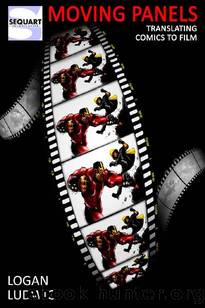Moving Panels: Translating Comics to Film by Logan Ludwig

Author:Logan Ludwig [Ludwig, Logan]
Language: eng
Format: epub
Publisher: Sequart Organization
Published: 2015-02-19T00:00:00+00:00
A young Satrapi is confronted by the Guardians of the Revolution. From The Complete Persepolis. Art by Marjane Satrapi. Copyright © Marjane Satrapi.
The next portion of the scene also allows us to see how the film reconfigures the presentation of the story to focus on the motion of the characters. After Marjane drives down the price of the tape in a series of seven rapidly shifting close ups of her and the vendor (a sequence which plays much more swiftly and effectively on the screen than a series of seven panels could hope to play on the page), the movie cuts to the lower half of two black figures sliding across the street from right to left. These are the Guardians of the Revolution and in the comic they are introduced in a car driving through the background as Marjane, walking down the street, thinks about the tapes she just purchased. If the filmic composition was re-rendered and transformed into a comic panel, it would likely make little sense. It would merely be two black figures on a street with little context and it would be missing the ominous slithering sound effect that accompanies their entrance in the film. It is not out of the question that some readers would be able to infer that these are actually people clad in burkas, but then the creator would also have to contend with how to imply motion. Motion lines could help render movement through a panel, but another problem arises here: how would the reader know that these black shapes are coming after Marjane? The film utilizes the right-to-left movement to create awareness in the viewer that the shapes are headed in Marjaneâs direction. This version of Persepolis would have trouble making this right-to-left movement work without being slightly confusing because it violates the traditional left-to-right reading order. Satrapi could simply feature the black shapes moving from left to right and all would be fine, but this does not necessarily convince the audience that the threat is real. The power of these shapes in the film comes not from their depictionâthey are not particularly terrifyingâbut from their slow and unnatural motion and the sliding hiss sound effect that accompanies them. Cinema alone can render the fear and aversion of Satrapiâs rapacious theocratic wards, but the comic presents the Guardians in a car that is bearing down on Marjane, representing their character and intentions using static iconography. This doesnât mean that the comic is less provocative because the film plays more subtly with the Guardiansâ appearance, but only that the comic must effectively tell the story for an audience that relies heavily on stark visual clues to access the narrative. Both versions of Persepolis strive for clarity, and the choices made in each version of this scene speak to how clarity can be achieved.
Stopping her, the Guardians of the Revolution are next depicted questioning Marjane; they decide to bring her in until she tells a story of dread and woe, attempting to convince them to have mercy.
Download
This site does not store any files on its server. We only index and link to content provided by other sites. Please contact the content providers to delete copyright contents if any and email us, we'll remove relevant links or contents immediately.
Kathy Andrews Collection by Kathy Andrews(10521)
The remains of the day by Kazuo Ishiguro(7551)
Spare by Prince Harry The Duke of Sussex(4199)
Paper Towns by Green John(4169)
The Body: A Guide for Occupants by Bill Bryson(3802)
Be in a Treehouse by Pete Nelson(3214)
Harry Potter and the Goblet Of Fire by J.K. Rowling(3046)
Goodbye Paradise(2964)
Never by Ken Follett(2884)
Into Thin Air by Jon Krakauer(2703)
The Remains of the Day by Kazuo Ishiguro(2620)
The Genius of Japanese Carpentry by Azby Brown(2609)
The Cellar by Natasha Preston(2595)
Drawing Shortcuts: Developing Quick Drawing Skills Using Today's Technology by Leggitt Jim(2532)
120 Days of Sodom by Marquis de Sade(2439)
Architecture 101 by Nicole Bridge(2351)
The Man Who Died Twice by Richard Osman(2300)
Machine Learning at Scale with H2O by Gregory Keys | David Whiting(2293)
Fairy Tale by Stephen King(2071)
